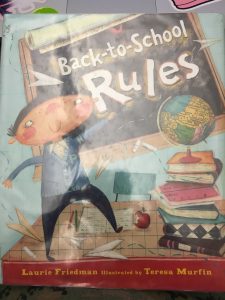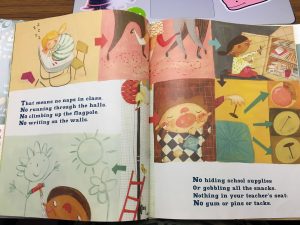 Title: Back-to-School Rules
Title: Back-to-School Rules
Author: Laurie Friedman
Illustrator: Teresa Murfin
Publisher: Carolrhoda Books, 2011
Number of pages: 32 pages
Tags: Fiction, Picture Book, K-5, Stephanie Prentice
Genre: Fiction
Analysis
During this story, Percy offers his rules for going back to school for the year. He explains what not to do during class in order to be successful. Percy claims that if someone follows his ten rules that they will have a lot of fun during school.
This book can act as a window for children to see themselves in the story. For example, children can imagine themselves in their own classroom and reflect on their behavior. However, the lack of diversity does not allow for children to see cultures that are different from their own. The images create a humorous depiction of school, showing students doing very silly things such as swimming in the fish tank. In some cases, the images contradict the text.
The images are very colorful and vibrant, grabbing the reader’s attention. The beginning of the book begins with Percy walking to school through his town. The images often mirror the text,  depicting the behaviors that Percy claims you should not do . Percy’s rules are often a different color in the text. The illustrator uses different techniques to display the information. For example, on one page, she uses arrows to display the order of which it appears in the text. On the next page, she uses a thought cloud to display the rules. The illustrator also uses a chalkboard to display the rules of Percy. Structurally, the text has a slight rhyming scheme. However, it is sometimes forced, making it difficult to hear the rhyming.
depicting the behaviors that Percy claims you should not do . Percy’s rules are often a different color in the text. The illustrator uses different techniques to display the information. For example, on one page, she uses arrows to display the order of which it appears in the text. On the next page, she uses a thought cloud to display the rules. The illustrator also uses a chalkboard to display the rules of Percy. Structurally, the text has a slight rhyming scheme. However, it is sometimes forced, making it difficult to hear the rhyming.
This book is a funny way of discussing class rules; however, it is displayed in a very negative way. This book lists many things that students should not do, rather than stating what the students can do in a positive manner. For example, Percy claims that a student should not arrive late because teachers do not like to wait. Sometimes when a student is late it is out of their control. This list of behaviors to avoid can make children afraid for what can happen if they were to break one of these rules. This book does a good job of opening the discussion for classroom rules, but should not be used to tell children how to act in school. Many of the rules limit the children’s creativity and abilities because of the harsh negativity.
